Intrahepatic Bile Duct Carcinoma: Comprehensive Overview
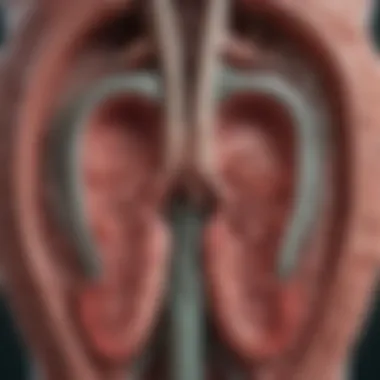
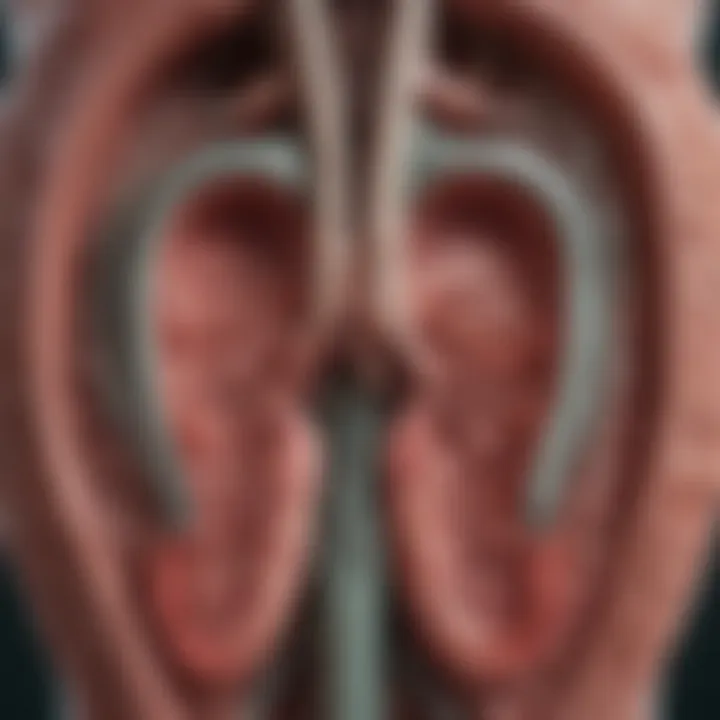
Overview of Research Topic
Brief Background and Context
Intrahepatic bile duct carcinoma (IBDC) is a rare but aggressive form of cancer that originates from the epithelial cells lining the bile ducts within the liver. This condition contributes to the overall burden of hepatobiliary malignancies and is often associated with poor prognosis. The incidence of IBDC is increasing, partly due to greater awareness and advancements in imaging techniques, resulting in earlier detection.
The pathology of IBDC remains complex, involving multifactorial influences including genetics, environmental factors, and underlying liver diseases such as cirrhosis and viral hepatitis. Despite ongoing advancements in medical research, the fundamental mechanisms driving the progression of intrahepatic bile duct carcinoma still require extensive investigation.
Importance in Current Scientific Landscape
Research into IBDC is vital not only for enhancing clinical outcomes but also for improving our understanding of its pathophysiology. In recent years, various studies have shaped our knowledge regarding risk factors, leading to refined diagnostic criteria and more targeted therapeutic strategies. The exploration of potential biomarkers for early detection holds promise for significantly impacting patient management. As the field expands, insights gained from current studies may ultimately translate into improved treatment options and survival rates for patients afflicted with this malignancy.
Methodology
Research Design and Approach
A comprehensive literature review was conducted to gather existing knowledge related to intrahepatic bile duct carcinoma. Various scholarly articles, clinical trials, and recent findings were analyzed to capture the current understanding of the disease, its treatment, and ongoing research efforts. The objective was to create a cohesive narrative that encompasses all relevant aspects of IBDC.
Data Collection Techniques
Data was sourced from reputed databases like PubMed and various clinical journals. Information was also extracted from research papers that delve into the biological mechanisms underlying IBDC, as well as those that study the epidemiological trends and advancements in diagnostic techniques. Additional insights were garnered from discussions in forums such as reddit.com, enhancing a well-rounded perspective on patient experiences and expert opinions.
"Intrahepatic bile duct carcinoma's prevalence is a growing concern within the medical community, underscoring the urgency for research that leads to better understanding and management strategies."
This structured approach allows for a detailed examination of the disease, laying the foundation for further sections that will explore the pathophysiology, clinical presentation, and therapeutic strategies in depth.
Understanding Intrahepatic Bile Duct Carcinoma
In the realm of hepatobiliary malignancies, intrahepatic bile duct carcinoma (IBDC) presents distinct challenges that demand a thorough understanding. This section underscores the importance of comprehending IBDC. When one understands the nuances, it opens avenues for better diagnosis and management strategies. Knowledge surrounding this carcinoma enhances awareness about its implications on liver health and patient outcomes.
Definition and Characteristics
Intrahepatic bile duct carcinoma, often referred to as cholangiocarcinoma, is a type of cancer that arises from the bile ducts within the liver. It is relatively rare but is increasingly recognized as a significant contributor to liver cancer mortality. Characteristically, this carcinoma can present in various forms, often classified based on the anatomic location and histological features.
The majority of cases present as adenocarcinomas that can be both infiltrative and mass-forming. A crucial aspect of IBDC is the late presentation of symptoms, often leading to a poor prognosis. Common characteristics include:
- Obstructive jaundice due to bile duct blockage
- Weight loss
- Abdominal pain
Diagnosis can be complex due to the overlap of symptoms with other diseases. Therefore, recognizing these characteristics is vital for clinicians to initiate timely interventions.
Anatomy of the Bile Ducts
Understanding the anatomy of the bile ducts is essential in grasping how IBDC develops and spreads. The bile ducts consist of an intricate network of tubes that transport bile from the liver to the gallbladder and small intestine. These ducts can be categorized into intrahepatic and extrahepatic bile ducts.
- Intrahepatic Bile Ducts: These are located within the liver and are responsible for collecting bile produced by the hepatocytes. Here, the bile ductules converge into larger ducts.
- Extrahepatic Bile Ducts: These ducts lie outside the liver and extend to the duodenum. The common bile duct merges with the cystic duct from the gallbladder to form the main passage for bile.
The intrahepatic ducts are thinner-walled and more delicate compared to their extrahepatic counterparts. Because of their anatomical location, tumors arising here can easily invade liver tissue, complicating treatment options.
"Comprehending the bile duct anatomy not only aids in understanding the disease but also contributes to more accurate staging and treatment planning."
Recognizing the structure and function of bile ducts can better equip healthcare professionals to address intrahepatic bile duct carcinoma effectively.
Epidemiology
Epidemiology is a critical aspect of understanding intrahepatic bile duct carcinoma. The study of disease distribution, patterns, and determinants provides insights essential for prevention, early detection, and treatment strategies. This section will delve into the incidence and prevalence, geographic distribution, and demographic factors that influence the occurrence of this malignancy.
Incidence and Prevalence
Intrahepatic bile duct carcinoma is not an everyday diagnosis, and its incidence varies based on several factors. The current global incidence is relatively low compared to other cancers, impacting approximately 1-2 cases per 100,000 people annually. However, its rates are increasing in some regions, particularly in Southeast Asia and parts of Europe.
Research shows that it often correlates with underlying liver diseases like hepatitis B and C or cirrhosis. The prevalence can often be misleading as conditions contributing to the development of this carcinoma lead to complications that can mask the underlying issue. Understanding these statistics is essential for healthcare experts, as it guides resource allocation for prevention and treatment.
Geographic Distribution
Geographic distribution of intrahepatic bile duct carcinoma offers significant insights into environmental and genetic risk factors. The highest rates of this cancer are reported in countries such as Vietnam, Thailand, and the Eastern regions of China. The reasons often relate to the prevalence of liver flukes, specifically Opistorchis viverrini and Clonorchis sinensis, which are endemic in these areas.
In contrast, lower incidences can be found in Western countries, where screening and treatment for hepatitis infections are prevalent. Understanding these geographic trends allows public health interventions to focus on high-risk regions, promoting education and preventative healthcare measures.
Demographic Factors
Demographic elements play an influential role in the manifestation of intrahepatic bile duct carcinoma. Data indicates that this cancer is more common in older adults, particularly those over the age of 65. Gender also plays a role, with a higher ratio of affected males compared to females.
Additional factors like ethnicity and socioeconomic status are important. In areas where there is a higher prevalence of chronic liver conditions, specific ethnic groups exhibit greater susceptibility. Educational and income levels may affect access to healthcare and screening programs, further complicating incidence rates.
In summary, the epidemiological aspects of intrahepatic bile duct carcinoma emphasize the need for targeted research and healthcare policies to address the varying incidence rates, geographic nuances, and demographic challenges that present themselves across populations.
Understanding the epidemiology of intrahepatic bile duct carcinoma represents a foundational step in creating effective public health strategies. By focusing on these elements, healthcare systems can better prepare for and respond to the ongoing challenges presented by this cancer.
Pathophysiology
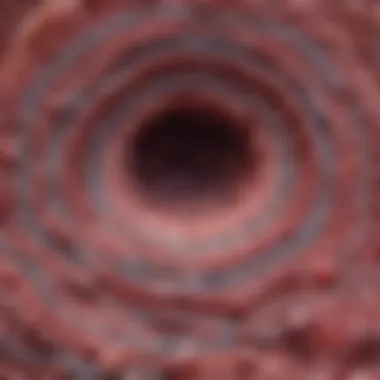
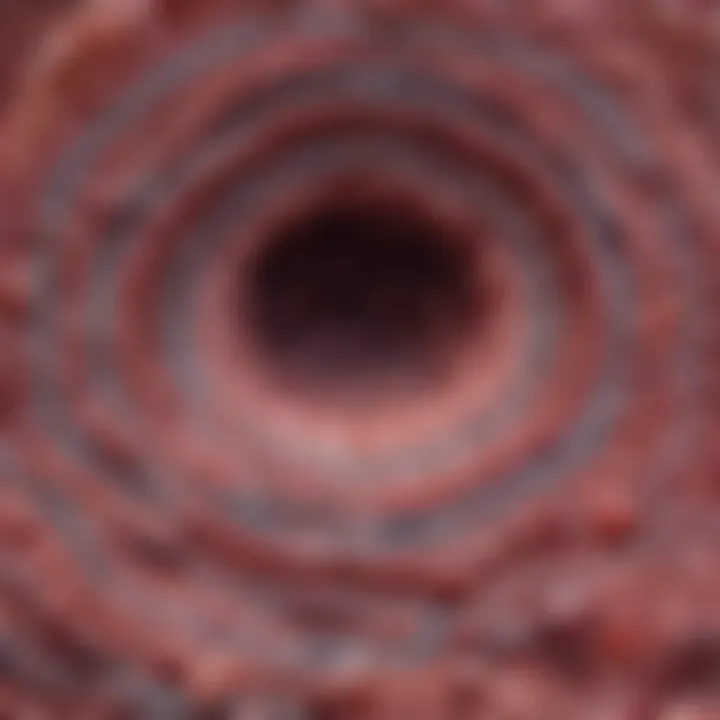
The pathophysiology of intrahepatic bile duct carcinoma is critical to understanding the disease's progression and treatment. This section elucidates the molecular mechanisms behind the carcinoma, explores genetic and epigenetic alterations, and examines the tumor microenvironment. By understanding these aspects, we can identify potential interventions and improve patient outcomes.
Molecular Mechanisms
Intrahepatic bile duct carcinoma arises due to complex interactions on a molecular level. Key signaling pathways, such as the Wnt/β-catenin and MAPK pathways, are often aberrantly activated in these tumors. These pathways contribute to cell proliferation, survival, and migration, promoting tumor development.
Furthermore, cholangiocarcinogenesis often involves the dysregulation of tumor suppressor genes, like TP53, and oncogenes, such as KRAS. These mutations disrupt normal cell cycle regulation, leading to unrestrained cellular growth. Understanding these molecular mechanisms is essential for developing targeted therapies. It allows researchers to focus on specific pathways and molecules for intervention, which may lead to better therapeutic strategies.
Genetic and Epigenetic Alterations
Genetic changes play a significant role in the progression of intrahepatic bile duct carcinoma. Common alterations include mutations in genes involved in cell cycle regulation and apoptosis. For instance, CDKN2A and ARID1A are frequently mutated in these cancers, highlighting the genetic landscape that predisposes individuals to this malignancy.
On the other hand, epigenetic modifications, such as DNA methylation and histone modification, can silence tumor suppressor genes without altering the DNA sequence. Such alterations can contribute to the carcinogenic process by preventing normal cellular mechanisms from functioning effectively. This duality of genetic and epigenetic changes emphasizes the need for comprehensive genomic profiling in patients, which might pave the way for personalized approaches in treatment.
Tumor Microenvironment
The tumor microenvironment of intrahepatic bile duct carcinoma is a key player in its pathophysiology. It consists of various cell types, including immune cells, fibroblasts, and endothelial cells, which interact with tumor cells. This environment can promote tumorigenesis through a myriad of factors, such as cytokines and growth factors that facilitate tumor growth and metastasis.
Moreover, the presence of immune cells in the tumor microenvironment can either aid or inhibit cancer progression. For example, regulatory T cells might inhibit anti-tumor immunity, whereas other immune cells could trigger a supportive cascade for tumor growth. Understanding these interactions is crucial for developing immunotherapies and targeted interventions that can potentially modulate the tumor microenvironment to the patient's advantage.
"An enhanced understanding of the pathophysiology of intrahepatic bile duct carcinoma lays the groundwork for future therapeutic advancements."
Ultimately, the interplay of these factors in the pathophysiology of intrahepatic bile duct carcinoma informs not only the diagnosis but also the treatment strategies employed. The ongoing research is pivotal for unveiling novel approaches to tackle this challenging disease.
Risk Factors
Understanding the risk factors associated with intrahepatic bile duct carcinoma is crucial for the identification and prevention of this challenging malignancy. By recognizing these factors, medical professionals can better inform patients about their individual risks and guide targeted screening strategies. This knowledge can enhance early detection efforts and improve overall management outcomes for affected individuals.
Chronic Liver Disease
Chronic liver disease is a significant contributor to the development of intrahepatic bile duct carcinoma. Conditions such as cirrhosis, hepatitis B, and hepatitis C infections are well-documented risk elements.
- Cirrhosis leads to an environment that promotes inflammation and cellular turnover, increasing the likelihood of malignant transformation in bile duct cells.
- Hepatitis infections particularly carry a higher risk over time, as they often lead to chronic liver inflammation. Persistent inflammation can cause DNA damage, presenting opportunities for cancerous changes.
Patients with these chronic conditions should have regular screenings. Liver function tests and imaging can aid in early detection of any changes that may suggest cancer development.
Exposure to Chemicals
Exposure to certain chemicals is another important risk factor linked to intrahepatic bile duct carcinoma.
The following substances have been noted as potential carcinogens:
- Aflatoxins: Naturally occurring toxins produced by mold found on crops, such as peanuts and corn.
- Chlorinated hydrocarbons: This group includes substances like dichloromethane, which is used in industrial processes.
Individuals who work in environments with high levels of chemical exposure, such as in agriculture or chemical manufacturing, should take precautions. Reducing exposure can significantly lower the risk of developing liver-related illnesses, including bile duct cancers.
Genetic Predispositions
Genetic factors also play a role in the emergence of intrahepatic bile duct carcinoma. Certain hereditary conditions lead to an increased susceptibility to this form of cancer.
For example:
- Individuals with familial adenomatous polyposis (FAP) or Lynch syndrome are at elevated risk due to genetic mutations that affect DNA repair mechanisms.
- Congenital biliary tract anomalies, such as biliary cysts, have also been studied as significant risk factors.
Genetic counseling and regular health monitoring are recommended for individuals with a family history of these conditions. Genetic predisposition underscores the importance of tailored surveillance and preventive measures in patient management.
Understanding these risk factors allows for informed decisions regarding lifestyle changes and medical interventions.
By identifying these risks, healthcare practitioners can take proactive measures, such as lifestyle modification and close monitoring, that may improve outcomes for individuals predisposed to developing intrahepatic bile duct carcinoma.
Clinical Presentation
The concept of clinical presentation is crucial in understanding intrahepatic bile duct carcinoma. Recognizing the early signs and symptoms can significantly influence patient outcomes. Timely identification leads to prompt intervention, which is vital in a disease known for its late-stage presentation. Furthermore, understanding clinical features helps clinicians in making accurate diagnoses and formulating effective treatment strategies. This section explores the key symptoms and staging processes that clinicians use to evaluate the condition.
Symptoms and Signs
The symptoms of intrahepatic bile duct carcinoma can often be vague and nonspecific, leading to challenges in early diagnosis. Many patients may present with:
- Jaundice: This is a common symptom, marked by yellowing of the skin and eyes due to the accumulation of bilirubin. Jaundice can occur as a result of bile duct obstruction, which is frequently seen in this type of cancer.
- Abdominal Pain: Patients often report discomfort or pain in the upper right quadrant of the abdomen. This can be due to the mass effect of the tumor or associated inflammation.
- Unintentional Weight Loss: Significant weight loss may occur in patients, often related to poor appetite or metabolic changes associated with cancer.
- Fatigue: A feeling of exhaustion is another frequent complaint, impacting the quality of life.
- Itching: Known as pruritus, this can accompany jaundice and results from elevated bilirubin levels in the blood.
Other less common symptoms include fever, elevated liver enzymes, and changes in stool or urine color. These signs often prompt further investigation to ascertain the underlying cause.
Staging of the Disease
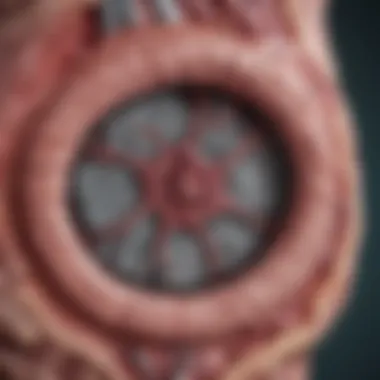
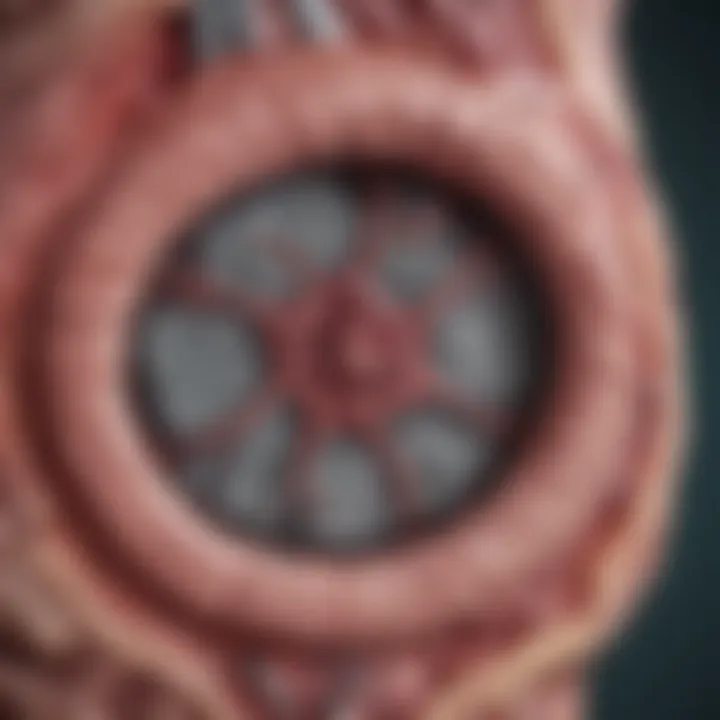
Staging intrahepatic bile duct carcinoma is essential for determining the extent of the disease and planning treatment. The American Joint Committee on Cancer (AJCC) staging system is commonly employed.
This system categorizes the disease based on:
- Tumor Size (T): This looks at the primary tumor and its invasive characteristics, categorizing it from T1 (confined to the bile duct) to T4 (involving adjacent structures).
- Regional Lymph Nodes (N): It assesses whether the cancer has spread to nearby lymph nodes, with classifications from N0 (no nodal involvement) to N1 (regional lymph node involvement).
- Distant Metastasis (M): This evaluates if the cancer has spread to distant sites in the body; M0 indicates no distant spread while M1 indicates the presence of metastasis.
The staging process influences treatment decisions, and understanding these stages allows for better prognostic assessments. Accurate staging can lead to personalized treatment plans and improved patient management strategies.
Recognizing symptoms and accurately staging the disease are key to improving outcomes in patients with intrahepatic bile duct carcinoma. Early detection is integral.
Diagnostic Approaches
The diagnostic approaches for intrahepatic bile duct carcinoma are critical in ensuring timely and accurate detection of the disease. An early diagnosis can significantly improve treatment outcomes, as staged interventions can offer more options to patients. Combining various diagnostic techniques offers a complete picture of the disease, allowing healthcare providers to devise the most effective management strategies. In this section, we will elaborate on the essential methods utilized in the diagnosis of intrahepatic bile duct carcinoma, including imaging techniques, biopsy and histopathology, and tumor markers.
Imaging Techniques
Imaging techniques play a vital role in the initial detection and staging of intrahepatic bile duct carcinoma. Several modalities are utilized to visualize the anatomy of the liver and bile ducts, as well as to identify any lesions. The most common imaging techniques include:
- Ultrasound: This is often the first-line imaging modality for liver lesions. It is non-invasive, readily available, and highly sensitive for detecting bile duct dilation and liver abnormalities.
- Computed Tomography (CT): CT scans provide detailed cross-sectional images of the abdomen and are essential for assessing the extent of the disease. They help in identifying the presence of metastasis or local invasion.
- Magnetic Resonance Imaging (MRI): MRI is particularly useful in evaluating soft tissue structures. It offers better visualization of bile ducts and liver than CT and is advantageous in assessing vascular involvement.
- Cholangiography: This technique specifically visualizes the biliary tree. It can be performed via endoscopic or percutaneous approaches to obtain images that clarify the extent of the bile duct obstruction.
These imaging techniques not only assist in diagnosing the carcinoma but also guide any potential surgical interventions. However, the selection of appropriate imaging depends on various factors, including patient characteristics and availability of technology.
Biopsy and Histopathology
Following imaging, a biopsy is often necessary to confirm the diagnosis of intrahepatic bile duct carcinoma. Biopsy provides tissue samples that undergo histopathological examination. There are different methods of performing a biopsy:
- Percutaneous Biopsy: This involves using a needle to sample liver tissue under imaging guidance. It is minimally invasive and carries low risks of complications.
- Endoscopic Biopsy: In cases where cholangiography indicates strictures, endoscopic techniques may be utilized to obtain tissue samples directly from the bile ducts.
- Surgical Biopsy: In certain cases, a surgical procedure may be required for definitive diagnosis, particularly if the tumor is resectable.
Histopathology examines the cellular characteristics of the tissue, providing critical information regarding the tumor type and grade. Diagnosis may reveal specific features that guide targeted therapy and further management strategies. Accurately distinguishing between different types of tumors is crucial, as treatment approaches vary.
Tumor Markers
Tumor markers are biological substances that can be utilized in the diagnosis and monitoring of intrahepatic bile duct carcinoma.
- CA 19-9: This is one of the most commonly studied tumor markers for biliary tract cancers. Elevated levels often indicate malignancy, but may also be seen in various benign liver conditions, which necessitates careful interpretation.
- CEA (Carcinoembryonic Antigen): This marker is useful in conjunction with CA 19-9 and is sometimes elevated in cases of bile duct carcinoma.
These markers can aid in the diagnosis, but they are not definitive on their own. The integration of tumor marker levels with imaging and biopsy findings is essential for a correct diagnosis.
Collectively, the right combination of imaging techniques, biopsy, histopathological analysis, and tumor marker evaluation provides a robust diagnostic framework, permitting effective management decisions in intrahepatic bile duct carcinoma.
Therapeutic Strategies
The therapeutic strategies for intrahepatic bile duct carcinoma are crucial for addressing this challenging malignancy. With the disease often diagnosed at advanced stages, effective treatment is necessary to manage symptoms, prolong survival, and improve quality of life. Each strategy plays a significant role and may vary depending on individual factors such as the cancer stage, patient’s overall health, and response to treatment. This section will explore the main therapeutic interventions available for managing intrahepatic bile duct carcinoma, highlighting their benefits and considerations.
Surgical Interventions
Surgical intervention is generally the primary treatment for resectable intrahepatic bile duct carcinoma. The aim is to completely remove the tumor along with a margin of healthy tissue. Common surgical approaches include liver resection and liver transplantation. The choice between them relies on tumor location and patient health.
- Liver Resection: This involves the surgical removal of the tumor and surrounding liver tissue. Its success depends on the ability to remove all cancerous cells. However, this procedure carries risks, such as complications from liver dysfunction, especially in patients with underlying liver disease.
- Liver Transplantation: For patients with tumors confined to the bile duct without vascular invasion, transplantation may be the best option. It provides a new, healthy liver, increasing the chance of survival. Eligibility for this option requires careful evaluation, emphasizing the need for a donor match and the absence of extrahepatic spread.
Surgery can lead to improved outcomes but is best suited for patients with localized disease. Those with advanced stages may not benefit from surgical procedures alone.
Radiation Therapy
Radiation therapy can be an essential component of treatment, especially when surgical options are limited. It is most effective in combination with other treatments. There are two primary forms: external beam radiation and internal radiation.
- External Beam Radiation Therapy: This method targets the tumor from outside the body using high-energy rays. It helps to reduce tumor size, manage symptoms, and improve the patient's discomfort.
- Brachytherapy: Involves placing radioactive material directly inside or very close to the tumor. It enables a targeted approach, minimizing damage to surrounding healthy tissues.
Radiation therapy can also be beneficial as a palliative treatment to relieve symptoms such as pain or obstruction caused by tumor growth.
Chemotherapy and Targeted Therapies
Chemotherapy remains a cornerstone for treating advanced intrahepatic bile duct carcinoma, particularly in non-resectable cases. It involves the use of drugs to kill cancer cells or stop their growth. Drugs such as Gemcitabine combined with Cisplatin are commonly utilized.
- Chemotherapy: It can be given before surgery (neoadjuvant) to shrink tumors or after (adjuvant) to eliminate remaining cells. This approach aims to improve surgical outcomes. However, systemic side effects due to the drugs often necessitate careful monitoring.
- Targeted Therapies: These newer treatments focus on specific molecular changes in cancer cells. Such therapies may include agents that target particular genetic mutations or pathways, potentially enhancing effectiveness. Emerging studies are investigating their role in improving survival rates.
In summary, therapeutic strategies for intrahepatic bile duct carcinoma are multifaceted and tailored to individual patient needs. Each treatment modality presents benefits and challenges. Patients benefit from a comprehensive care approach where surgical interventions, radiation therapy, and chemotherapy or targeted therapies are utilized in conjunction. As research progresses, these strategies will continue to evolve, optimally improving patient outcomes.
Emerging Research and Future Directions
Emerging research in intrahepatic bile duct carcinoma is essential for various reasons. First, it opens new avenues for better detection methods and treatments. Studying this cancer type is critical, as traditional therapies often show limited effectiveness. By examining modern research trends, clinicians and researchers can identify innovative strategies that may improve patient outcomes.
Novel Therapeutic Agents
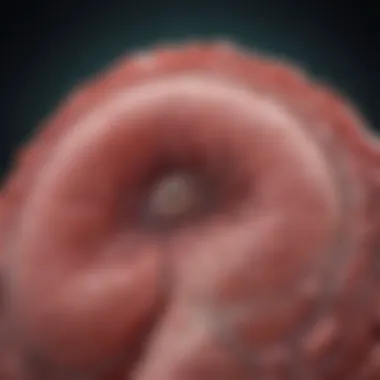
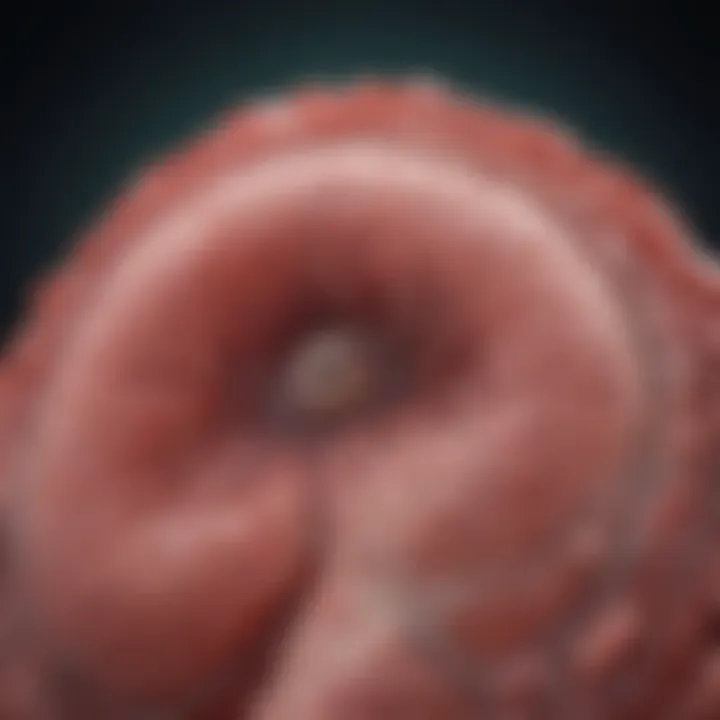
The development of novel therapeutic agents is a driving force behind advancing treatment protocols. One category of these agents includes targeted therapies that focus on specific molecular drivers of the cancer. Drugs such as idelalisib and regorafenib, have shown promise in clinical settings. These agents target pathways that are essential for tumor growth and survival, aiming to inhibit cancer cells without affecting normal tissues.
Additionally, immunotherapies are gaining traction. Agents like nivolumab harness the body's immune system to fight the cancer. As researchers explore these alternatives, understanding their efficacy and potential side effects becomes crucial.
Clinical Trials
Clinical trials represent a cornerstone of refining treatment approaches. Ongoing studies are testing combinations of new drugs and existing treatments. These trials are key to establishing the effectiveness of novel agents. For instance, trials involving combination immunotherapy may yield insights into synergistic effects, enhancing progression-free survival rates.
Participating in clinical trials provides patients access to cutting-edge therapies. It also aids researchers in collecting valuable data to inform future studies. Moreover, validating promising therapies through rigorous trial phases can lead to quicker approvals and clinical use.
Potential for Personalized Medicine
Personalized medicine is potentially transformative for the management of intrahepatic bile duct carcinoma. By tailoring treatment plans based on individual genetic profiles, healthcare providers can enhance therapeutic efficacy. Biomarkers guide clinicians in choosing the most appropriate therapy for each patient.
This approach recognizes the heterogeneity of cancer. It acknowledges that each patient's tumor may possess unique genetic alterations affecting its behavior and response to treatment. Additionally, integrating genomic data into clinical practice may refine risk assessments and inform monitoring strategies.
Emerging approaches in research represent a vital aspect of future directions, potentially leading to improved patient care and outcomes.
In summary, focusing on emerging research and the future direction of intrahepatic bile duct carcinoma holds immense promise. Through the development of novel therapeutic agents, participation in clinical trials, and the push toward personalized medicine, the landscape of diagnosis and treatment is set to evolve. Such advancements are crucial in the ongoing battle against this challenging disease.
Patient Management and Support
Effective management and support for patients with intrahepatic bile duct carcinoma is crucial, particularly due to the complex nature of the disease. This section explores key components, benefits, and considerations that play an integral role in the overarching patient care framework. The approach is multifaceted, incorporating various specialties to address not only the medical needs but also the emotional, psychological, and social aspects of patient well-being.
Multidisciplinary Care
Multidisciplinary care involves a collaborative approach among healthcare professionals from different specialties. In the context of intrahepatic bile duct carcinoma, this may include hepatologists, oncologists, radiologists, surgeons, and palliative care specialists. The significance of this approach is evident in numerous ways:
- Comprehensive Treatment Plans: A team can evaluate the disease from multiple perspectives, ensuring an informed treatment strategy that addresses specific patient needs.
- Enhanced Communication: Close cooperation among experts allows for streamlined communication. Patients receive consistent messages about their care, reducing confusion.
- Tailored Support Services: By recognizing the diverse challenges faced by patients, teams can provide tailored psychological, nutritional, and rehabilitative support.
This model is grounded in the belief that pooling expertise improves outcomes, leading to more effective management of intrahepatic bile duct carcinoma.
Palliative Care Options
Palliative care is an essential component of treatment for patients with advanced intrahepatic bile duct carcinoma. It focuses on improving quality of life, addressing not just physical symptoms but also emotional and spiritual needs. Important aspects of palliative care include:
- Symptom Management: Palliative care teams specialize in controlling pain, nausea, and other distressing symptoms. This can involve medications and therapeutic interventions tailored to the patient’s specific symptoms.
- Psychological Support: Counseling and support groups may help patients cope with the emotional toll of the illness. Mental wellness is crucial in enabling patients to navigate their diagnosis and treatment.
- Family Involvement: Palliative care involves families in discussions and decisions. This collective approach ensures that care aligns with the patient’s values and preferences, promoting a supportive environment.
"Palliative care does not hasten or postpone death; rather, it aims to enhance the quality of life for both patients and their families."
Ultimately, integrating effective patient management strategies, including multidisciplinary care and palliative options, fosters a comprehensive support system that can lead to improved patient experiences and outcomes in the face of a challenging diagnosis.
Prognosis and Outcomes
Understanding the prognosis and outcomes of intrahepatic bile duct carcinoma (IBDC) is crucial for both patients and healthcare professionals. The prognosis often guides clinical decision-making and informs patients about their options and the expected course of the disease. Intrahepatic bile duct carcinoma is notorious for its late presentation and aggressive nature, leading to a generally poor prognosis. Early intervention can significantly influence outcomes, emphasizing the need for awareness and early detection strategies.
Survival Rates and Prognostic Factors
Survival rates for intrahepatic bile duct carcinoma can vary widely based on several factors, including stage at diagnosis, surgical resectability, and individual patient characteristics.
- Stage at Diagnosis: Most patients are diagnosed at advanced stages due to non-specific symptoms. The survival rate decreases significantly as the disease progresses. For instance, patients diagnosed with localized tumors may have a five-year survival rate of around 30% to 50%, while those with metastatic disease often have a survival rate below 5%.
- Surgical Resectability: Surgical resection remains the most effective treatment for improving long-term outcomes. Patients who undergo a successful surgical procedure often experience better survival rates than those treated with chemotherapy or supportive care alone. The absence of vascular invasion and clear surgical margins are positive prognostic indicators.
- Prognostic Factors: Other important factors influencing survival include the presence of lymph node metastasis, underlying liver function, and the patient's overall health condition. An elevated carbohydrate antigen 19-9 (CA 19-9) level at diagnosis can also indicate a worse prognosis.
"Intrahepatic bile duct carcinoma, while rare, illustrates the profound impact of surgical timing and technique on survival rates."
Long-Term Follow-Up
Long-term follow-up is essential for patients recovering from intrahepatic bile duct carcinoma. This phase is vital for detecting potential recurrences, managing treatment side effects, and ensuring overall quality of life. Regular follow-ups typically include imaging studies, lab tests, and clinical evaluations. These assessments help in monitoring liver function and identifying any new symptoms or complications that may arise post-treatment.
- Frequency of Check-Ups: Frequency of follow-up visits generally varies depending on the initial treatment approach. After resection, patients are often monitored every three to six months in the first two years and then annually, provided there are no complicating factors.
- Life After Diagnosis: Survivorship care may include nutritional counseling, physical therapy, and palliative measures as necessary. Addressing psychosocial aspects is also crucial, as many patients face emotional and social challenges after their cancer journey.
In summary, understanding the prognosis and long-term management options for intrahepatic bile duct carcinoma is crucial for improving patient outcomes. Continuous monitoring and a well-structured follow-up plan can help in enhancing quality of life and survival rates.
Summary and Epilogue
Intrahepatic bile duct carcinoma is a critical subject within the realm of hepatobiliary malignancies. Its complexity requires a comprehensive understanding that factors in multiple disciplines. The summary and conclusion of this article emphasize the core takeaways while discussing the implications of existing knowledge and future advancements in the field.
The importance of this conclusion lies primarily in its ability to synthesize crucial concepts related to intrahepatic bile duct carcinoma. It recaps the challenges associated with its diagnosis, the biological underpinnings, and the various treatment modalities available. Moreover, this section draws the reader’s attention to the necessity of multidisciplinary approaches in the management of the disease, considering factors such as patient support, therapeutic interventions, and ongoing research developments.
By summarizing key insights from each section, this conclusion provides a clear roadmap for students, researchers, educators, and healthcare professionals alike, fostering deeper engagement with the vital knowledge on this topic.
Key Takeaways
- Intrahepatic bile duct carcinoma presents significant clinical challenges due to its late diagnosis and aggressive nature.
- A thorough understanding of the disease's pathophysiology and risk factors is crucial for effective management.
- Diagnostic techniques, including imaging and histopathology, play a pivotal role in timely detection.
- Therapeutic strategies should be personalized, integrating surgical options, chemotherapy, and supportive care based on individual patient profiles.
- Ongoing research is essential to uncover novel therapeutic targets and improve prognostic outcomes for patients.
Future Implications for Research
Future research endeavors must prioritize several crucial aspects to enhance the understanding and treatment of intrahepatic bile duct carcinoma. Potential pathways for exploration include:
- Molecular Profiling: Developing a better understanding of genetic and epigenetic alterations may lead to novel biomarkers for early detection.
- Innovative Treatment Approaches: Investigating new therapeutic agents that target specific molecular pathways associated with this carcinoma can lead to more effective treatment regimens.
- Enhanced Clinical Trials: Conducting clinical trials that assess the efficacy of immunotherapies and combination treatments will provide valuable data on optimal management strategies.
- Patient-Centric Approaches: Research into personalized medicine may offer insights into tailoring treatments based on the individual patient’s genetic makeup and disease characteristics.
- Longitudinal Studies: Investigating long-term outcomes of patients treated with various modalities will help refine treatment protocols and improve survival rates.



